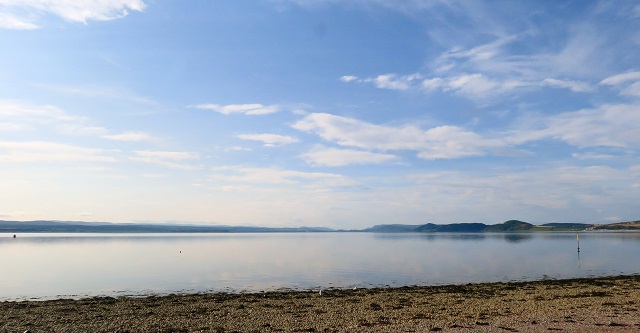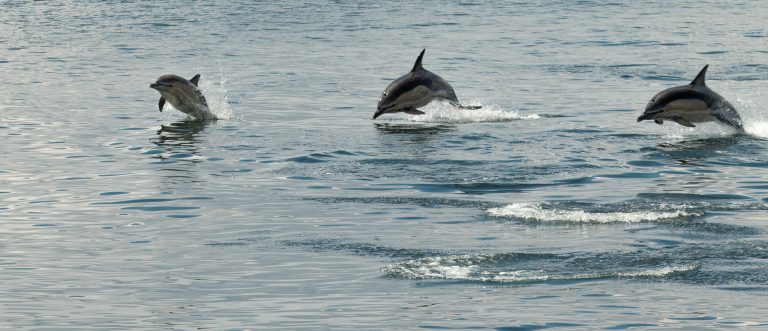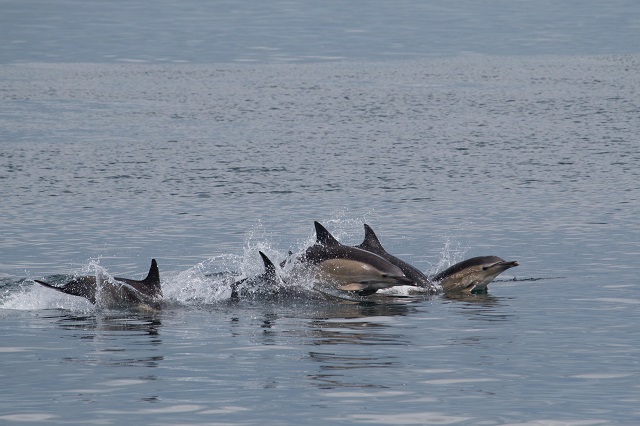Scotland is one of the best places in the world to go whale and dolphin watching. There are good viewpoints on both the east and west coast and in the northern isles and Hebrides, so you have a good chance of spotting them wherever on the coast your motorhome takes you. A motorhome holiday also gives you a lot of flexibility in your itinerary, and you can pick and choose the best places for a spot of whale or dolphin watching.
The main whale and dolphin watching season in Scotland runs from March to September, though it varies from place to place and from species to species (dolphins are often seen year-round). The great thing about Scotland, from the whale-watching point of view, is that it has hundreds of miles of coastline so your chances of being in the right place at the right time are enormously increased. It also has some terrific beach-side camping spots, both official and wild.
Moray Firth
Probably the most famous area in Scotland for seeing dolphins is the Moray Firth, from Fraserburgh to Inverness, where there’s a resident population of around 130 bottlenose dolphins. The Moray Firth is very wide at its mouth, so your chances of seeing dolphins improve from Findhorn westwards.
Dolphins so near land feed on the rising tide, so you need to know what the tide is doing. There are two ways to find that out: the EasyTide site, and the Tides Near Me app which is available free for both Android and iPhone. If you’re using EasyTide, remember that their times are in GMT regardless of the time of year, so you’ll have to add one hour in summer-time. Get to your chosen viewpoint when the tide is just beginning to rise to have the best chance of seeing something.

The best viewpoint is at Chanonry Point, a spit of land opposite Fort George that almost closes the channel, where dolphins are regularly seen. There’s a car park here but it does tend to get very congested, so you’re better parking near Fortrose or Rosemarkie and walking down.
A visit to Fort George, the other side of the Firth, is also highly recommended. It has a large car park and you could do your dolphin watching from the ramparts, then warm up in the Fort café (this is a windy spot!). Alternatively, if you’re not into military history, park in the car park and walk down to the beach.
If you’re in the area between March and October you could also go to the Scottish Dolphin Centre in Spey Bay, between Lossiemouth and Buckie. They have very well-informed staff who can answer all your questions, and there’s plenty to see, indoors and out, even if no dolphins show up. Seals, ospreys and otters live nearby, and they have the UK’s biggest icehouse, not to mention whale bones you can see and touch. There are guided and unguided walks and plenty for kids to do and, best of all if you’re travelling with the family, entry is free.
The rest of the east coast
The North Sea around Eyemouth and between Dundee and Aberdeen is well-known for cetacean sightings. You might see long-finned pilot whales, minke whales, porpoises and dolphins of all sorts, including orca (sometimes known as killer whales, though they’re actually the largest species of dolphin).
2017 has been a great year for cetacean sightings all down the east coast of Scotland, especially orca. A humpback whale, a rare visitor to these waters, was also seen in the Montrose area. However, you’re most likely to see common and bottlenose dolphins and harbour porpoises feeding, breaching and riding the bow-waves of small boats.
The east coast orcas follow the herring fishing fleet south and stay to feed on seal pups, so the best time to see them are from May to August. Whales are occasional visitors, to be celebrated when you spot one. The dolphins and porpoises are resident, though, so you may see them and enjoy their antics at any time of the years.
Shetland, Orkney and the Pentland Firth
The waters around the north of Scotland and the northern island groups of Orkney and Shetland are teeming with fish and seals and with the sea mammals that feed on them.
Around Shetland, the commonest sightings are of orca, but you could also see long-finned pilot whales and minke whales. Other species regularly seen here include Risso’s and Atlantic white-sided dolphins and harbour porpoises.
Despite being only a few nautical miles away, Cape Wrath and Orkney have a slightly different range of species. Here you’re most likely to see common, white-beaked and Risso’s dolphins, orca, harbour porpoises and minke whales.

The west coast and Hebrides
The orcas here are thought to be a different genetic population from the ones on the east coast and they are resident year-round, with a range that runs from the Outer Hebrides to Galloway. The 10 orcas in the pod are thought to be past breeding age, as no calf has been seen with them in the past 20 years. They hunt other cetaceans (up to minke whale size) rather than fish.
You may also see fin and minke whales, harbour porpoises and Risso’s, bottlenose, common and white-beaked dolphins. The best places to see them are from inter-island ferries, with specialist tour operators who know where to look (see below) or, on dry land, from Ardnamurchan Point, around the Isle of Mull and at Red Point to the south of Gairloch.
The other large marine beast you may see in the western waters (and sometimes round the northern isles, too) is not a cetacean but a fish: the basking shark. It’s largest of the shark family but poses no threat to humans because it’s a filter-feeder (it has no teeth).
These huge animals swim slowly, mouths agape, drawing in vast quantities of water and filtering out the fish and plankton. If you want to see them, and maybe dive or snorkel with them, Basking Shark Scotland in Oban is the specialist tour operator.
Whale and dolphin watching from the water

Numerous companies all around Scotland offer whale and dolphin watching boat trips. You may also see seals, puffins, otters, sea eagles and other wildlife, depending on the time of year.
Some of the best wildlife boat tour operators in eastern Scotland are Dolphin Spirit at Inverness and Ecoventure in Cromarty, both for the Moray Firth, and Pirate Boats in Dundee for the southern east coast. For the west coast and the Hebrides, you have plenty of choice: Sealife Adventures and Seafari Adventures, both near Oban; Hebridean Whale Cruises of Gairloch, near Poolewe; SkyeXplorer Boat Trips at Uig on the Isle of Skye; and Sea Life Surveys at Tobermory on the Isle of Mull.
There are no specific whale and dolphin watching boat trips in the northern isles, but you may see cetaceans as you tour Scapa Flow or Mousa sound or from the ferry on your way to and from the islands.
Wherever you go in Scotland you’re never far from the coast, so keep your eyes open and your binoculars handy and be prepared to stop when you spot something interesting. A motorhome holiday gives you the freedom to move around and take to where the action is; good luck and happy whale and dolphin watching!